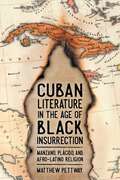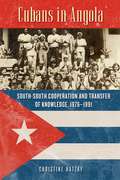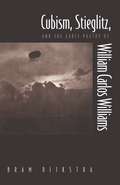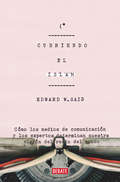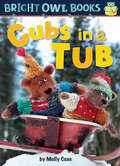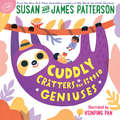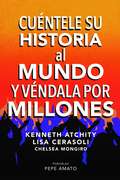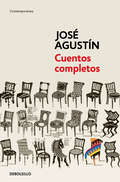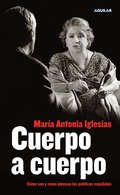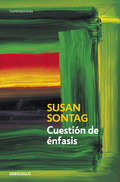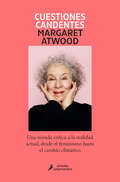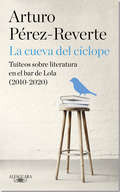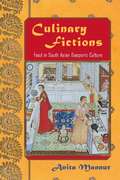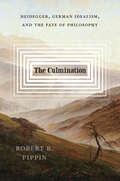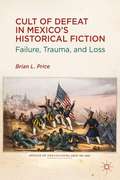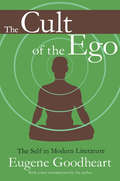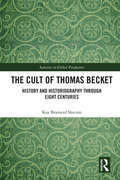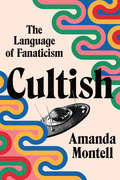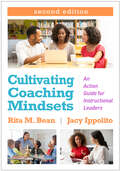- Table View
- List View
The Cubalogues: Beat Writers in Revolutionary Havana
by Todd TietchenImmediately after the Cuban Revolution, Havana fostered an important transnational intellectual and cultural scene. Later, Castro would strictly impose his vision of Cuban culture on the populace and the United States would bar its citizens from traveling to the island, but for these few fleeting years the Cuban capital was steeped in many liberal and revolutionary ideologies and influences.Some of the most prominent figures in the Beat Movement, including Allen Ginsberg, Lawrence Ferlinghetti, and Amiri Baraka, were attracted to the new Cuba as a place where people would be racially equal, sexually free, and politically enfranchised. What they experienced had resounding and lasting literary effects both on their work and on the many writers and artists they encountered and fostered.Todd Tietchen clearly documents the multiple ways in which the Beats engaged with the scene in Havana. He also demonstrates that even in these early years the Beat movement expounded a diverse but identifiable politics.
Cuban Intersections of Literary and Urban Spaces
by Carlos RiobóCuban Intersections of Literary and Urban Spaces examines Havana as a center where urban and literary spaces often come together. The idea for this collection of essays grew out of an international conference on Cuba, Cuba Futures: Past and Present, held by the City University of New York's Bildner Center for Western Hemisphere Studies at CUNY's Graduate Center in 2011, but evolved out of a collaboration with scholars in the fields of literature, architecture, urban planning, and library science. The topics addressed peek at a dynamic Cuban nation through its cultural interstices at a crucial moment in the island's evolving history. This conference proceeding opens with a piece on the intersections between Havana's colonial built environment and the literary aesthetic of the Baroque in the Caribbean. The collection continues with the following areas of study: urban gardens, urban planning, architecture, literary projections on space, international relations and cultural institutions, access to books, and social policies.
Cuban Literature in the Age of Black Insurrection: Manzano, Plácido, and Afro-Latino Religion (Caribbean Studies Series)
by Matthew PettwayJuan Francisco Manzano and Gabriel de la Concepción Valdés (Plácido) were perhaps the most important and innovative Cuban writers of African descent during the Spanish colonial era. Both nineteenth-century authors used Catholicism as a symbolic language for African-inspired spirituality. Likewise, Plácido and Manzano subverted the popular imagery of neoclassicism and Romanticism in order to envision black freedom in the tradition of the Haitian Revolution. Plácido and Manzano envisioned emancipation through the lens of African spirituality, a transformative moment in the history of Cuban letters. Matthew Pettway examines how the portrayal of African ideas of spirit and cosmos in otherwise conventional texts recur throughout early Cuban literature and became the basis for Manzano and Plácido’s antislavery philosophy. The portrayal of African-Atlantic religious ideas spurned the elite rationale that literature ought to be a barometer of highbrow cultural progress. Cuban debates about freedom and selfhood were never the exclusive domain of the white Creole elite. Pettway’s emphasis on African-inspired spirituality as a source of knowledge and a means to sacred authority for black Cuban writers deepens our understanding of Manzano and Plácido not as mere imitators but as aesthetic and political pioneers. As Pettway suggests, black Latin American authors did not abandon their African religious heritage to assimilate wholesale to the Catholic Church. By recognizing the wisdom of African ancestors, they procured power in the struggle for black liberation.
Cubans in Angola
by Christine HatzkyAngola, a former Portuguese colony in southern central Africa, gained independence in 1975 and almost immediately plunged into more than two decades of conflict and crisis. Fidel Castro sent Cuban military troops to Angola in support of the Movimento Popular de Libertação de Angola (MPLA), leading to its ascension to power despite facing threats both international and domestic. What is less known, and what Cubans in Angola brings to light, is the significant role Cubans played in the transformation of civil society in Angola during these years. Offering not just military support but also political, medical, administrative, and technical expertise as well as educational assistance, the Cuban presence in Angola is a unique example of transatlantic cooperation between two formerly colonized nations in the global South.
Cubism, Stieglitz, and the Early Poetry of William Carlos Williams
by Bram DijkstraPrevious studies of William Carlos Williams have tended to look only for the literary echoes in his verse. According to Bram Dijkstra, the new movements in the visual arts during the 1920s affected Williams's work as much as, if not more than, the new writing of the period. Dijkstra catches the excitement of this period of revolutionary art, reveals the interactions between writers and painters, and shows in particular the specific and general impact this world had on Williams's early writings.
Cubriendo el islam: Cómo los medios de comunicación y los expertos determinan nuestra visión del resto del mundo
by Edward W. SaidUna obra más necesaria que nunca para reconsiderar la visión que recibimos del islam. Desde la crisis de los rehenes en Irán hasta la guerra del Golfo y el primer atentado con bomba en el World Trade Center, la mayoría de los medios de comunicación estadounidenses han retratado el islam como una entidad monolítica equivalente a terrorismo y a fanatismo religioso. Al mismo tiempo algunos países islámicos lo invocan para justificar regímenes no democráticos y a menudo represivos. En esta obra clásica, revisada posteriormente por el autor, Edward W. Said examina el origen y la repercusión de las imágenes del islam en los medios de comunicación y revela los objetivos ocultos y la distorsión de los hechos que subyacen incluso en gran parte de los artículos más «objetivos» sobre el mundo islámico. Said demuestra cómo algunos de los supuestos expertos sobre el islam son en muchas ocasiones especialistas improvisados y periodistas que van a países cuyo idioma, literatura, historia y cultura desconocen, o analistas aficionados a las generalizaciones que, a veces sin saberlo, caen en el prejuicio, la caricatura y el estereotipo. Con un nuevo prefacio del hijo del autor, Wadie Said, y una introducción del traductor, Bernardino León Gross, este libro se convierte en nuestros días en una obra más necesaria que nunca para reconsiderar la visión que recibimos del islam.
Cubs in a Tub (Bright Owl Books)
by Molly CoxeRuss and Gus are bored . . . until they take a tub for a ride. This fun photographic easy-to-read story features the short "u" vowel sound. Kane Press's new series of super simple easy-to-reads, Bright Owl Books, launches with Molly Coxe's five photographic stories, which feature the short vowel sounds and are each only around 100 words. These irresistibly silly stories help kids learn to read through repetition and by teaching the basic building blocks of reading—vowel sounds—giving kids the perfect start on educational success.
Cuddly Critters for Little Geniuses (Big Words for Little Geniuses #2)
by James Patterson Susan Patterson Hsinping PanAxolotes, chinchillas, and sugar gliders--oh my!In this charmingly illustrated follow-up to their first bestselling collaboration, Big Words for Little Geniuses, Susan and James Patterson create a collection of the world's oddest and cutest animals that only little geniuses would know!From sloths to spoonbills and panda ants to pangolins, little geniuses will love learning about all of the unusual, adorable animals that live on this planet. More than 50 little-known flyers, swimmers, and crawlers are included in this book, whimsically illustrated by artist Hsinping Pan. Cuddly Critters for Little Geniuses will remind you that nature contains many wonders--and these cute and curious creatures are no exception!
Cuéntele su Historia al Mundo y Véndala por Millones
by Kenneth Atchity Lisa CerasoliCuéntele su Historia al Mundo y Véndala por Millones, es un libro infaltable tanto para escritores como para guionistas. Posee todo aquello que no le dicen a uno mientras cursa una carrera relacionada con la creación literaria. Pero no solamente son los meros datos de usos y costumbres de los mercados editoriales, también de los nuevos mercados y las posibilidades de una edición electrónica sin pasar por las casas editoriales. ¡Ni hablar de hacer que su historia esté "en forma" para la soñada posibilidad de que su libro se convierta en una película! Este libro lo ayudará efictivamente a contar su historia al mundo, y lo ayudará a venderla por millones!!!
Cuentos
by Charles PerraultUn gato que se las trae; Pulgarcito, un niño tan pequeño como valeroso; una Caperucita Roja que se deja engañar ingenuamente; la hermosa Cenicienta y sus envidiosas hermanastras... son los principales personajes cuyas aventuras y desventuras se narran en estos cuentos inmortales.
Cuentos completos
by José AgustínTodos los cuentos de José Agustín, el autor más emblemático de La Onda y uno de los mejores narradores en México. Esta antología reúne todas las narraciones cortas que José Agustín publicara entre 1968 y 2002: desde Inventando que sueño (1968), No hay censura (1988) y No pases esta puerta (1992), hasta los relatos de Los grandes discos de rock (2001) y el extenso relato inédito Los ojos de los demás (2002). Ésta es, en pocas palabras, la recopilación que los lectores de José Agustín esperábamos con tanto anhelo. Los relatos que aparecen en Cuentos completos destacan, como el resto de la obra de José Agustín, por su originalidad, por la fusión de la tradición con la rebeldía, por el humor, la irreverencia y por el profundo y sutil erotismo que habita estas historias. Cuentos completos incluye textos clásicos como Cuál es la onda, Amor del bueno y Transportarán a un cadáver por exprés, relatos que abrieron nuevos caminos para la narrativa mexicana y que representan una de las propuestas literarias más ambiciosas en la historia de nuestras letras.
Cuerpo a cuerpo: Cómo son y cómo piensan los políticos españoles
by María Antonia IglesiasCuerpo a cuerpo no es solo un libro de entrevistas a políticos de todos los partidos, de todas las ideas. Es el resultado de una apasionante aventura: la de aproximarse a los personajes sin máscaras. Para preguntar, para escuchar, para comprender. María Antonia Iglesias no es solo una gran entrevistadora, es una mujer que, desde su papel de periodista, intenta descubrir la realidad saltando por encima de los prejuicios y de los lugares comunes. En Cuerpo a cuerpo se reúnen sus mejores entrevistas, en su mayoría políticas, un subgénero condenado por su propia naturaleza a responder al día a día. Sin embargo, las de María Antonia Iglesias superan los márgenes de la actualidad para convertirse en el retrato de un personaje y de un momento de nuestra historia reciente. Quizá eso sucede porque aplica de forma generosa y constante una misma metodología, la que ella misma nos cuenta en la introducción de su libro: «Escuchar para aprender, para comprender. Éste ha sido el sentido último de las entrevistas que he publicado en El País en los últimos diez años y de las que he seleccionado para este libro las cien que mejor resumen el reto de enfrentar al personaje consigo mismo. Lograr que los entrevistados (políticos en su gran mayoría, que se blindan tanto) digan en alta voz aquello que piensan, pero que no tenían intención de decir, persuadirlos para que abandonen la posición defensiva y disfruten, incluso, con la verdad de sus reflexiones más recónditas. Ése era siempre mi objetivo en ese cuerpo a cuerpo a veces duro, estimulante siempre, en el que siempre también he buscado la verdadera inteligencia con el otro.»María Antonia Iglesias
El cuerpo y las olas
by Manuel VicentCompendio de artículos de Manuel Vicent. «Las columnas de Manuel Vicent no pretenden soportar ningún peso muerto; solo están escritas para el placer de los sentidos.»Joan Manuel Serrat Una vez más he caído en la tentación de darles una última oportunidad a las palabras que he escrito en el periódico antes de que se las lleve el viento. Uno espera que al convertirlas en libro suenen de otra forma y sorprendan al lector por un flanco inesperado. Tejer y destejer la manga del jersey de Penélope a lo largo de los días con un ovillo con el que juega el gato, en eso consiste en el fondo la literatura. Este libro contiene el fluido de la vida que uno ha visto pasar desde cualquier acera, a través de la ventanilla de un taxi, en la terraza de una cafetería o mirando al techo tumbado en el sofá. Pequeñas historias y sensaciones, balas perdidas que se han perdido en el mar. Día a día, ola a ola es como el cuerpo llega feliz a la orilla.Manuel Vicent
Cuestión de énfasis
by Susan SontagUn brillante libro de ensayos de Susan Sontag, sobre literatura, cine, fotografía, pintura, artes escénicas y sobre la figura del intelectual. Treinta y cinco años después de su primera colección de ensayos, el hoy clásico Contra la interpretación, Susan Sontag seleccionó cuarenta y un textos compuestos entre 1982 y 2003 y los dividió en las tres secciones de este libro. «Lecturas» recoge apasionados ensayos sobre escritores de su canon personal, como Barthes, Sebald, Borges, Tsvetáieva y Rulfo. En «Miradas» comparte su pasión por el cine, la fotografía, la pintura y las artes escénicas. Finalmente, en «Allí y aquí», indaga en su compromiso (y su activismo) por la construcción de una conciencia y en su vocación de escritora. Reseña:«Un documento para verificar el paso del tiempo en el cuerpo de una generación que se forjó en esa moneda de cara y cruz que fueron Nueva York y París en los años dorados.»Mauro Libertella, Página/12
Cuestiones candentes: Una mirada crítica a la realidad actual, desde el feminismo hasta el cambio climático
by Margaret AtwoodUna brillante colección de ensayos que abarca desde la deuda pública hasta la naturaleza de la ciencia ficción y la crisis climática. La galardonada y exitosa autora de El cuento de la criada y Los testamentos ofrece su divertida, erudita, curiosa y asombrosamente clarividente visión del mundo, desde la deuda y la tecnología hasta la crisis climática y la libertad, y busca respuestas a cuestiones candentes como... ¿Por qué la gente cuenta historias, sea cual sea su cultura? ¿Cuánto puedes dar de ti sin evaporarte? ¿Cómo podemos vivir en nuestro planeta? ¿Qué relación hay entre los zombis y el autoritarismo? Una colección de ensayos de actualidad con el marchamo indiscutible de la que quizá sea la novelista viva más famosa y, sin duda, la más venerable de nuestro tiempo. Reseñas:«Ésta no es una mera colección de ensayos para los entusiastas de Atwood. Más bien es un intento de dar sentido al mundo, que aborda con un brío característico cualquier cosa, desde Ana la de Tejas Verdes a Donald Trump, desde los zombis a la censura [...]. Mientras que el tono se mueve entre el ingenio surrealista fuera de serie y la gravedad desapasionada, Atwood siempre consigue que la idea de las grandes preguntassea un poco más digerible. [...] La colección es polifónica, entusiasta, esclarecedora.»Sophie Macintosh, i News «Es fascinante leer las reflexiones de Atwood sobre sus propias novelas [...], pero también es llamativo ver cuántas piezas incluye en este libro que celebran de manera generosa a otros escritores.»Stephanie Merritt, The Observer«Si hay una persona en el mundo cuya opinión sobre las cuestiones más apremiantes te gustaría conocer, seguramente sería Margaret Atwood. [...] Da respuesta a preguntas candentes sobre el cambio climático, el ascenso de Trump y sobre la deuda técnica.»Joanna Taylor, Evening Standard«Una colección de ensayos para devanarse los sesos de Margaret Atwood, la autora ganadora del premio Booker. Percepciones maravillosamente escritas que van desde los zombis a la crisis climática.»Stylist «Me bebí el libro el fin de semana pasado, de dos cálidos tragos.»Jennifer Senior, The Atlantic
La cueva del cíclope: Tuiteos sobre literatura en el bar de Lola (2010-2020)
by Arturo Pérez-ReverteDiez años de conversaciones sobre literatura en el bar de Lola. «Hablar de libros en Twitter es como hacerlo con los amigos en la barra de un bar -dice Arturo Pérez-Reverte-. Si conversar sobre libros siempre es un acto de felicidad, que una red social sirva para esto la hace especialmente valiosa. Ahí vuelco con naturalidad toda una vida de lectura, y ahí comparto, con la misma naturalidad, la vida de lectura de mis lectores. Y el lector es un amigo.» Arturo Pérez-Reverte cumple diez años en Twitter. Son muchos los temas de los que ha hablado en esta red en este período, pero los libros ocupan un lugar protagónico. Entre febrero de 2010 y marzo de 2020, ha escrito más 45.000 mensajes, muchos de ellos sobre literatura, tanto la suya propia como aquella que estaba leyendo o la que le ha marcado a través de los años como escritor. Estos mensajes conforman los encuentros virtuales con sus seguidores en el mítico bar de Lola y se suceden periódicamente desde ese lejano día en que se adentró en esta «cueva del cíclope», como él mismo dio en llamar a la red social. Entre los muchos aspectos relacionados con la literatura, los tuiteros le han preguntado por su próxima novela o por su proceso de escritura, y le han pedido recomendaciones de lectura. Este libro reúne, gracias a la labor compiladora de Rogorn Moradan, todas estas conversaciones directas y sin intermediarios que ha mantenido Arturo Pérez-Reverte con sus lectores. Frente al carácter inmediato y efímero de los comentarios en esta red, hay algunas cuentas que, como dice Rogorn, «contienen pepitas de oro que merece la pena preservar». La de Arturo Pérez-Reverte es una de ellas. Anímense a entrar y tómense algo. Lola abre el bar durante un buen rato esta vez. Clic.
Culinary Fictions: Food in South Asian Diasporic Culture
by Anita MannurFor South Asians, food regularly plays a role in how issues of race, class, gender, ethnicity, and national identity are imagined as well as how notions of belonging are affirmed or resisted. Culinary Fictions provides food for thought as it considers the metaphors literature, film, and TV shows use to describe Indians abroad. When an immigrant mother in Jhumpa Lahiri’s The Namesake combines Rice Krispies, Planters peanuts, onions, salt, lemon juice, and green chili peppers to create a dish similar to one found on Calcutta sidewalks, it evokes not only the character’s Americanization, but also her nostalgia for India. Food, Anita Mannur writes, is a central part of the cultural imagination of diasporic populations, and Culinary Fictions maps how it figures in various expressive forms. Mannur examines the cultural production from the Anglo-American reaches of the South Asian diaspora. Using texts from novels-Chitra Divakaruni’s Mistress of Spices and Shani Mootoo’s Cereus Blooms at Night-and cookbooks such as Madhur Jaffrey’s Invitation to Indian Cooking and Padma Lakshmi’s Easy Exotic, she illustrates how national identities are consolidated in culinary terms.
The Culmination: Heidegger, German Idealism, and the Fate of Philosophy
by Robert PippinA provocative reassessment of Heidegger’s critique of German Idealism from one of the tradition’s foremost interpreters. Heidegger claimed that Western philosophy ended—failed, even—in the German Idealist tradition. In The Culmination, Robert B. Pippin explores the ramifications of this charge through a masterful survey of Western philosophy, especially Heidegger’s critiques of Hegel and Kant. Pippin argues that Heidegger’s basic concern was to determine sources of meaning for human life, particularly those that had been obscured by Western philosophy’s attention to reason. The Culmination offers a new interpretation of Heidegger, German Idealism, and the fate of Western rationalism.
The Culmination: Heidegger, German Idealism, and the Fate of Philosophy
by Robert B. PippinA provocative reassessment of Heidegger’s critique of German Idealism from one of the tradition’s foremost interpreters. Heidegger claimed that Western philosophy ended—failed, even—in the German Idealist tradition. In The Culmination, Robert B. Pippin explores the ramifications of this charge through a masterful survey of Western philosophy, especially Heidegger’s critiques of Hegel and Kant. Pippin argues that Heidegger’s basic concern was to determine sources of meaning for human life, particularly those that had been obscured by Western philosophy’s attention to reason. The Culmination offers a new interpretation of Heidegger, German Idealism, and the fate of Western rationalism.
Cult of Defeat in Mexico’s Historical Fiction
by Brian L. PriceCult of Defeat in Mexico's Historical Fiction: Failure, Trauma, and Loss examines recent Mexican historical novels that highlight the mistakes of the nineteenth century for the purpose of responding to present crises.
The Cult of Kean
by Jeffrey KahanA Shakespearean actor who made his career on the public stage, whose sex life was known and discussed in Britain, America and France, Edmund Kean has inspired numerous writings, many biographies among them. But until now, no work has tackled the complicated and fascinating story of his literary appropriation, both in his own day and after his death. Dealing with the way a variety of canonical authors-including Byron, Coleridge, Keats, Dumas, Twain and Sartre-appropriated Kean through the centuries, The Cult of Kean traces a remarkable literary legacy. In each chapter Jeffrey Kahan discusses how many of history's greatest figures viewed Kean, and how these figures examined and discussed themselves in relation to-or projected themselves onto-a variety of constructions of the great actor. Kahan first explores the rise of Kean in light of rising democratic sympathies, then in light of Kean's equally autocratic dealings with playwrights, among them John Keats. He looks at Kean's sexual shenanigans at Drury Lane, exploring them in the wider social context of infidelity; and explores perceptions of Kean in America, during his 1820-1 and 1825-6 tours. The Cult of Kean cites many letters from Kean's mother and still others from his wife, none of which have been published previously. The study also features rare and interesting paintings of Kean, as well as depictions of how writers, actors and film makers continue to add to his remarkable literary legacy.
The Cult of the Ego: The Self in Modern Literature
by Eugene GoodheartGoethe once remarked that "every emancipation of the spirit is pernicious unless there is a corresponding growth of control." This remark may be taken as a motto for Eugene Goodheart's study of an aspect of the cultural history of the past two hundred years. In separate chapters on Rousseau, Stendhal, Goethe and Carlyle, Dostoevsky, Whitman, Lawrence, and Joyce, Goodheart discovers a community of concern which he calls the cult of the ego. All these writers examined here in one way or another deal with "the emancipation of the spirit" with all its promise and danger. The characteristic attempt is to "extend the boundaries of the self by going beyond the area of safety" and. thereby risking even the destruction of the self. They advance the claims of the self at the same time seeking the controls that will secure these claims. The artist-hero becomes the central figure in Goodheart's volume, since it is he who comes to exemplify the possibilities of the cult of the ego. Their efforts, Goodheart argues, have ambiguous results. The seeds of contemporary nihilism are in the failures of these writers to master the chaos of egoism, which they helped engender. But their heroism was partly in the effort of resistance: moral, religious, aesthetic. In a large portion of modern literature, resistance has been abandoned either out of exhaustion or out of fascination with the destructive tendency of modern life: in Beckett's phrase, "a world endlessly collapsing." In his introduction to this first paperback edition, Goodheart discusses the book's origin in relation to the counter-cultural unrest of 1968 when it was first published and weighs its theme of the emancipated self against current postmodern assertions of the "death of the author." The Cult of the Ego is written with admirable clarity and economy. Its interests are literary, moral and political. Moving freely and knowledgeably among various national literatures, Goodheart has made an original and valuable contribution to the field of comparative literature. Eugene Goodheart is Edytha Macy Gross Professor of Humanities Emeritus at Brandeis University. Among his books are Novel Practices: Classic Modern Fiction, Modernism and the Critical Spirit, Culture and the Radical Conscience, and Confessions of a Secular Jew: A Memoir, all available from Transaction.
The Cult of Thomas Becket: History and Historiography through Eight Centuries (Sanctity in Global Perspective)
by Kay Brainerd SlocumOn 29 December, 1170, Thomas Becket, Archbishop of Canterbury, was brutally murdered in his own cathedral. News of the event was rapidly disseminated throughout Europe, generating a widespread cult which endured until the reign of Henry VIII in the sixteenth century, and engendering a fascination which has lasted until the present day. The Cult of Thomas Becket: History and Historiography through Eight Centuries contributes to the lengthy debate surrounding the saint by providing a historiographical analysis of the major themes in Becket scholarship, tracing the development of Becket studies from the writings of the twelfth-century biographers to those of scholars of the twenty-first century. The book offers a thorough commentary and analysis which demonstrates how the Canterbury martyr was viewed by writers of previous generations as well as our own, showing how they were influenced by the intellectual trends and political concerns of their eras, and indicating how perceptions of Thomas Becket have changed over time. In addition, several chapters are devoted a discussion of artworks in various media devoted to the saint, as well as liturgies and sermons composed in his honor. Combining a wide historical scope with detailed textual analysis, this book will be of great interest to scholars of medieval religious history, art history, liturgy, sanctity and hagiography.
Cultish: The Language of Fanaticism
by Amanda Montell“One of those life-changing reads that makes you see—or, in this case, hear—the whole world differently.” —Megan Angelo, author of Followers“At times chilling, often funny, and always perceptive and cogent, Cultish is a bracing reminder that the scariest thing about cults is that you don't realize you're in one till it's too late.”—Refinery29.comThe New York Times bestselling author of The Age of Magical Overthinking and Wordslut analyzes the social science of cult influence: how “cultish” groups, from Jonestown and Scientologists to SoulCycle and social media gurus, use language as the ultimate form of power.What makes “cults” so intriguing and frightening? What makes them powerful? The reason why so many of us binge Manson documentaries by the dozen and fall down rabbit holes researching suburban moms gone QAnon is because we’re looking for a satisfying explanation for what causes people to join—and more importantly, stay in—extreme groups. We secretly want to know: could it happen to me? Amanda Montell’s argument is that, on some level, it already has . . .Our culture tends to provide pretty flimsy answers to questions of cult influence, mostly having to do with vague talk of “brainwashing.” But the true answer has nothing to do with freaky mind-control wizardry or Kool-Aid. In Cultish, Montell argues that the key to manufacturing intense ideology, community, and us/them attitudes all comes down to language. In both positive ways and shadowy ones, cultish language is something we hear—and are influenced by—every single day. Through juicy storytelling and cutting original research, Montell exposes the verbal elements that make a wide spectrum of communities “cultish,” revealing how they affect followers of groups as notorious as Heaven’s Gate, but also how they pervade our modern start-ups, Peloton leaderboards, and Instagram feeds. Incisive and darkly funny, this enrapturing take on the curious social science of power and belief will make you hear the fanatical language of “cultish” everywhere.
Cultivating Coaching Mindsets: An Action Guide for Instructional Leaders
by Rita M. Bean Jacy IppolitoNow in a revised and updated second edition for today's changing K–12 landscape, this book gives instructional coaches an innovative framework for building strong relationships and enacting positive change in schools. Emphasizing a systems approach, Rita M. Bean and Jacy Ippolito explain the multiple roles of the coach as change agent, facilitator, designer, and advocate. Vivid examples show how effective coaches draw on these mindsets in working with individual teachers and groups and in developing, implementing, and sustaining schoolwide instructional programs. The book is rich with &“Voices from the Field&” vignettes; chapter-opening questions; and end-of-chapter discussion prompts, learning activities, and resources. Reproducible coaching tools can be copied from the book or downloaded from the companion website. New to This Edition *Broader scope--addresses coaching across all instructional areas, not just literacy. *Discussions of virtual instruction and coaching, the coach's role in supporting equity, and other timely topics. *Significantly revised case study chapter, with three new cases. *Incorporates current research, lessons learned in the field, and the ongoing development of the mindsets model.


